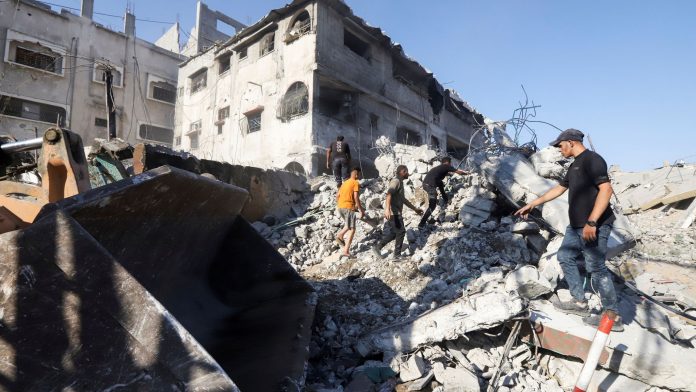Ceasefire talks in Cairo over the Gaza conflict have gained momentum. US President Donald Trump suggested that the talks could lead to a truce within a week. Qatar also emphasised the importance of seizing this diplomatic opportunity.
From the White House, during a peace accord signing between the Democratic Republic of the Congo and Rwanda, Mr Trump said he had spoken with people involved in earlier Gaza negotiations.
“We think within the next week, we’re going to get a ceasefire,” he said, offering no further detail.
Qatar, which is helping mediate along with the US and Egypt, echoed his remarks. Foreign Ministry spokesman Majed Al Ansari told AFP that talks with Israel and Hamas are ongoing. He said they aim to build on progress following the Israel-Iran ceasefire earlier this week.
“If we don’t use this momentum, it’ll be another missed opportunity,” he said. Mr Al Ansari added that US pressure had proved effective in securing the January truce.
Push for new truce after March breakdown
Efforts to restore a ceasefire resumed after Israel restarted its military operations in March. This happened two weeks after it stopped relief aid from entering Gaza, worsening the humanitarian crisis.
President Trump did not explain why he was confident this time. The US has made similar claims in the past, but talks stalled as both sides held firm.
The pace of talks in Cairo has picked up. US envoy Bishara Bahbah, a Palestinian-American, has held detailed meetings with Egyptian officials and Hamas leaders since Monday.
Steve Witkoff, another US envoy, will visit Egypt, Israel, and Qatar early next week.
An Israeli official visited Cairo earlier this week. More senior figures from Mossad and the Israeli military are expected soon. However, Israel has yet to confirm this.
Talks focus on 60-day truce and political framework
The proposals on the table are similar to those from earlier talks. However, the new focus is on adjusting them to allow a 60-day truce. During this time, parties would negotiate a longer ceasefire and a potential Israeli withdrawal from Gaza.
Israel, however, only supports a short-term truce and the release of all hostages. It also insists on keeping a security presence in Gaza and dismantling Hamas’s military and political leadership.
Hamas has shown some flexibility. It is willing to release 10 living hostages and the remains of several others. Israeli officials believe Hamas holds around 50 hostages, with 20 thought to be alive.
Hamas had proposed releasing the hostages gradually over 60 days. Israel rejected this and demanded the release of all 10 hostages on the first day of the truce.
Key disputes: Aid access, governance, and disarmament
Hamas also wants Israel to pull its troops from corridors used to deliver aid. It demands that a team of independent Palestinian technocrats begin managing Gaza as soon as the truce starts.
Talks also cover the idea of Hamas storing its weapons instead of disarming. Some senior Hamas leaders may agree to go into exile if Israel promises not to target them. Hamas has ruled out giving up its weapons entirely.
The war began when Hamas-led militants attacked southern Israel, killing around 1,200 people and capturing 250 others. Israel launched a heavy military response. According to Gaza authorities, over 56,000 Palestinians have died, and more than twice that number have been injured.
The fighting has displaced most of Gaza’s 2.3 million people and destroyed large parts of the territory.
